BULAW3731 - Taxation Law and Practice: Tax Policy Analysis Report
VerifiedAdded on 2023/03/20
|14
|3656
|47
Report
AI Summary
This assignment analyzes Australian taxation law, focusing on the impacts of various tax policies proposed and implemented in Australia. The report begins with an overview of proposed changes in personal tax, including tax offsets for lower and middle-income earners and budget declarations of tax cuts. It then explores proposals related to housing affordability, including negative gearing and capital gains tax. The report also examines tax concessions for institutional investors and the implications of discretionary trusts. The second part of the report discusses key attributes of a good tax system, such as productivity, elasticity, diversity, and the system's role in economic growth and stability. The analysis concludes with a discussion of the generosity of Australian tax concessions, particularly concerning property and the labor policy, and how it affects different income groups.
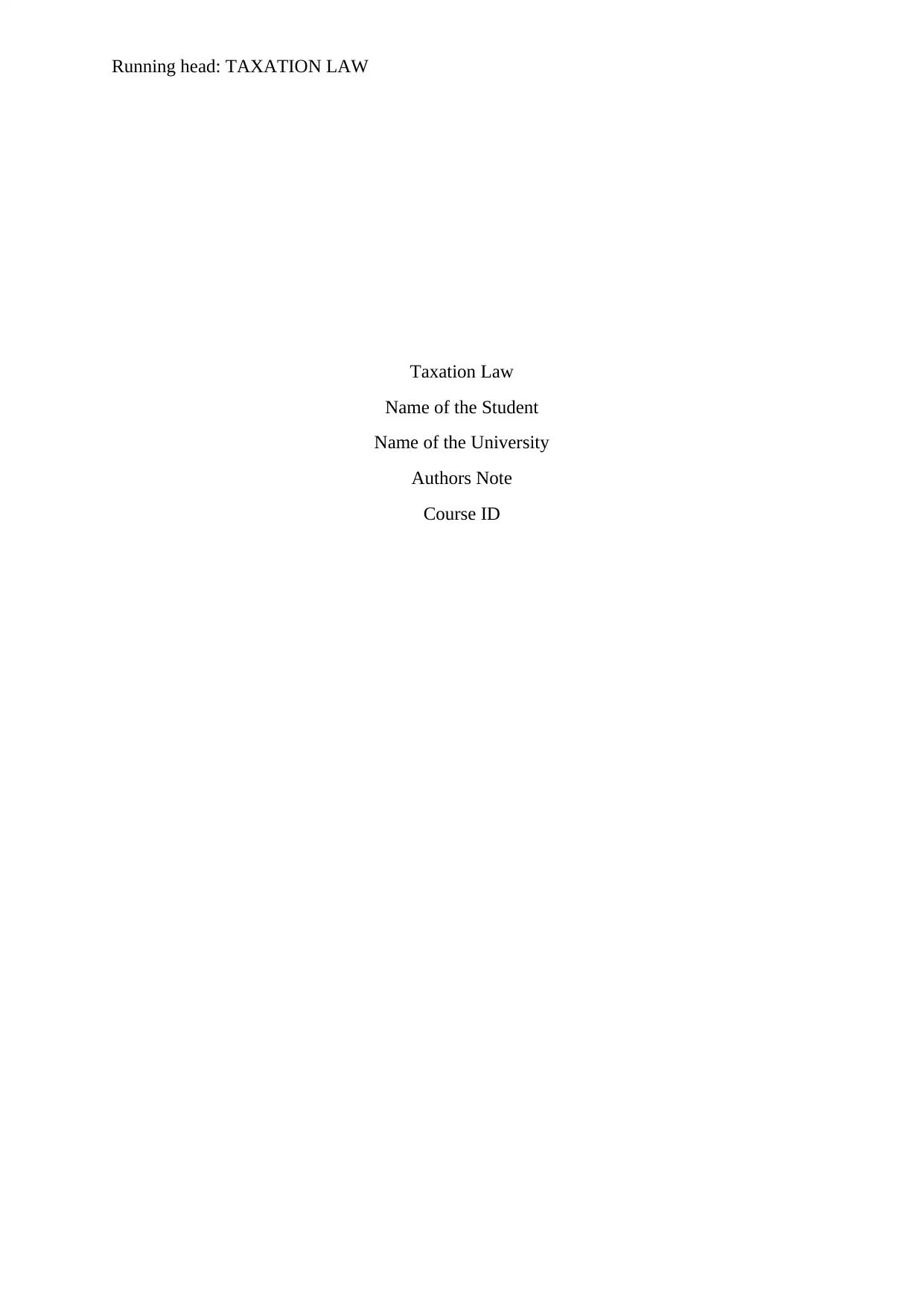
Running head: TAXATION LAW
Taxation Law
Name of the Student
Name of the University
Authors Note
Course ID
Taxation Law
Name of the Student
Name of the University
Authors Note
Course ID
Paraphrase This Document
Need a fresh take? Get an instant paraphrase of this document with our AI Paraphraser
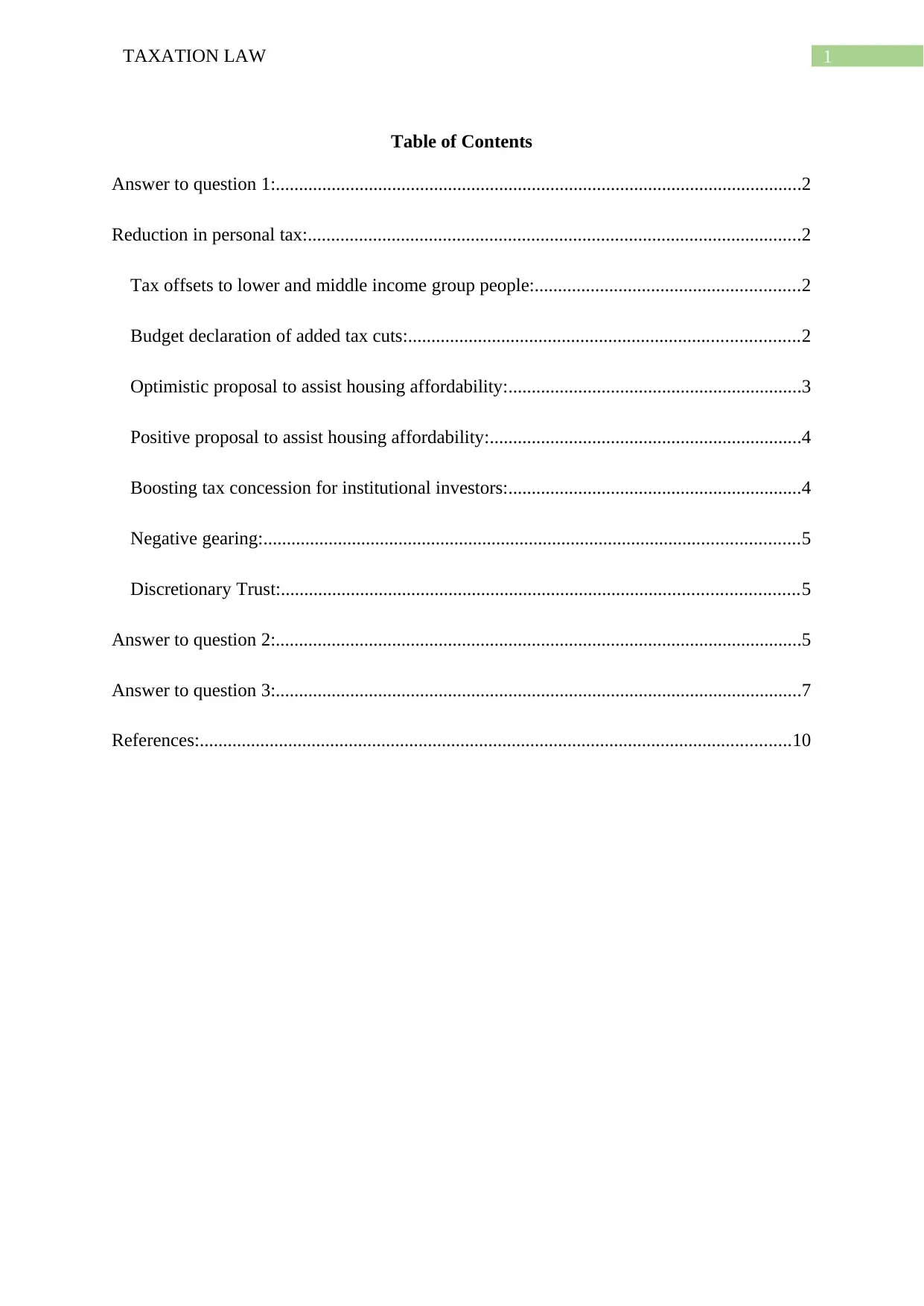
1TAXATION LAW
Table of Contents
Answer to question 1:.................................................................................................................2
Reduction in personal tax:..........................................................................................................2
Tax offsets to lower and middle income group people:.........................................................2
Budget declaration of added tax cuts:....................................................................................2
Optimistic proposal to assist housing affordability:...............................................................3
Positive proposal to assist housing affordability:...................................................................4
Boosting tax concession for institutional investors:...............................................................4
Negative gearing:...................................................................................................................5
Discretionary Trust:...............................................................................................................5
Answer to question 2:.................................................................................................................5
Answer to question 3:.................................................................................................................7
References:...............................................................................................................................10
Table of Contents
Answer to question 1:.................................................................................................................2
Reduction in personal tax:..........................................................................................................2
Tax offsets to lower and middle income group people:.........................................................2
Budget declaration of added tax cuts:....................................................................................2
Optimistic proposal to assist housing affordability:...............................................................3
Positive proposal to assist housing affordability:...................................................................4
Boosting tax concession for institutional investors:...............................................................4
Negative gearing:...................................................................................................................5
Discretionary Trust:...............................................................................................................5
Answer to question 2:.................................................................................................................5
Answer to question 3:.................................................................................................................7
References:...............................................................................................................................10
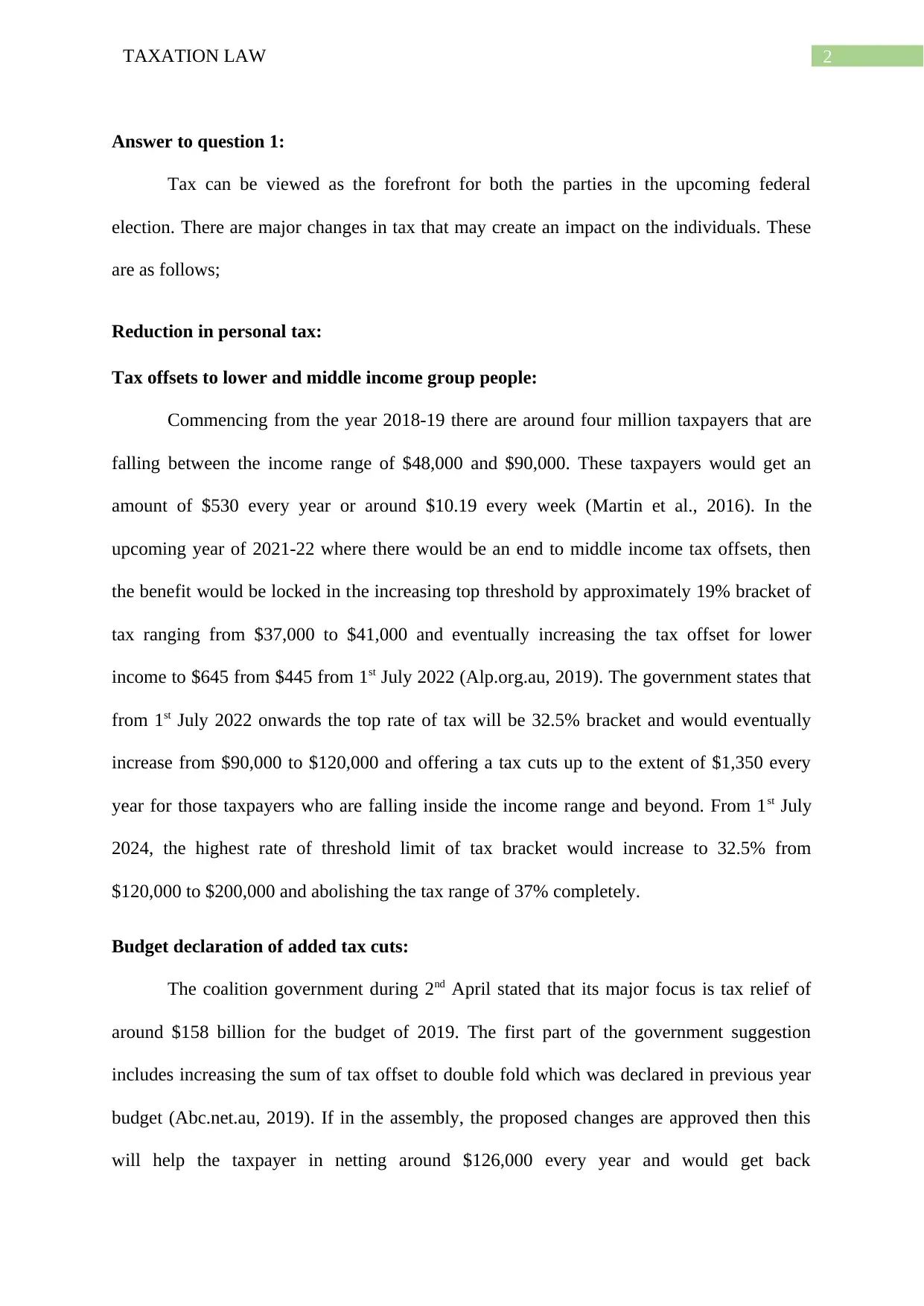
2TAXATION LAW
Answer to question 1:
Tax can be viewed as the forefront for both the parties in the upcoming federal
election. There are major changes in tax that may create an impact on the individuals. These
are as follows;
Reduction in personal tax:
Tax offsets to lower and middle income group people:
Commencing from the year 2018-19 there are around four million taxpayers that are
falling between the income range of $48,000 and $90,000. These taxpayers would get an
amount of $530 every year or around $10.19 every week (Martin et al., 2016). In the
upcoming year of 2021-22 where there would be an end to middle income tax offsets, then
the benefit would be locked in the increasing top threshold by approximately 19% bracket of
tax ranging from $37,000 to $41,000 and eventually increasing the tax offset for lower
income to $645 from $445 from 1st July 2022 (Alp.org.au, 2019). The government states that
from 1st July 2022 onwards the top rate of tax will be 32.5% bracket and would eventually
increase from $90,000 to $120,000 and offering a tax cuts up to the extent of $1,350 every
year for those taxpayers who are falling inside the income range and beyond. From 1st July
2024, the highest rate of threshold limit of tax bracket would increase to 32.5% from
$120,000 to $200,000 and abolishing the tax range of 37% completely.
Budget declaration of added tax cuts:
The coalition government during 2nd April stated that its major focus is tax relief of
around $158 billion for the budget of 2019. The first part of the government suggestion
includes increasing the sum of tax offset to double fold which was declared in previous year
budget (Abc.net.au, 2019). If in the assembly, the proposed changes are approved then this
will help the taxpayer in netting around $126,000 every year and would get back
Answer to question 1:
Tax can be viewed as the forefront for both the parties in the upcoming federal
election. There are major changes in tax that may create an impact on the individuals. These
are as follows;
Reduction in personal tax:
Tax offsets to lower and middle income group people:
Commencing from the year 2018-19 there are around four million taxpayers that are
falling between the income range of $48,000 and $90,000. These taxpayers would get an
amount of $530 every year or around $10.19 every week (Martin et al., 2016). In the
upcoming year of 2021-22 where there would be an end to middle income tax offsets, then
the benefit would be locked in the increasing top threshold by approximately 19% bracket of
tax ranging from $37,000 to $41,000 and eventually increasing the tax offset for lower
income to $645 from $445 from 1st July 2022 (Alp.org.au, 2019). The government states that
from 1st July 2022 onwards the top rate of tax will be 32.5% bracket and would eventually
increase from $90,000 to $120,000 and offering a tax cuts up to the extent of $1,350 every
year for those taxpayers who are falling inside the income range and beyond. From 1st July
2024, the highest rate of threshold limit of tax bracket would increase to 32.5% from
$120,000 to $200,000 and abolishing the tax range of 37% completely.
Budget declaration of added tax cuts:
The coalition government during 2nd April stated that its major focus is tax relief of
around $158 billion for the budget of 2019. The first part of the government suggestion
includes increasing the sum of tax offset to double fold which was declared in previous year
budget (Abc.net.au, 2019). If in the assembly, the proposed changes are approved then this
will help the taxpayer in netting around $126,000 every year and would get back
⊘ This is a preview!⊘
Do you want full access?
Subscribe today to unlock all pages.

Trusted by 1+ million students worldwide
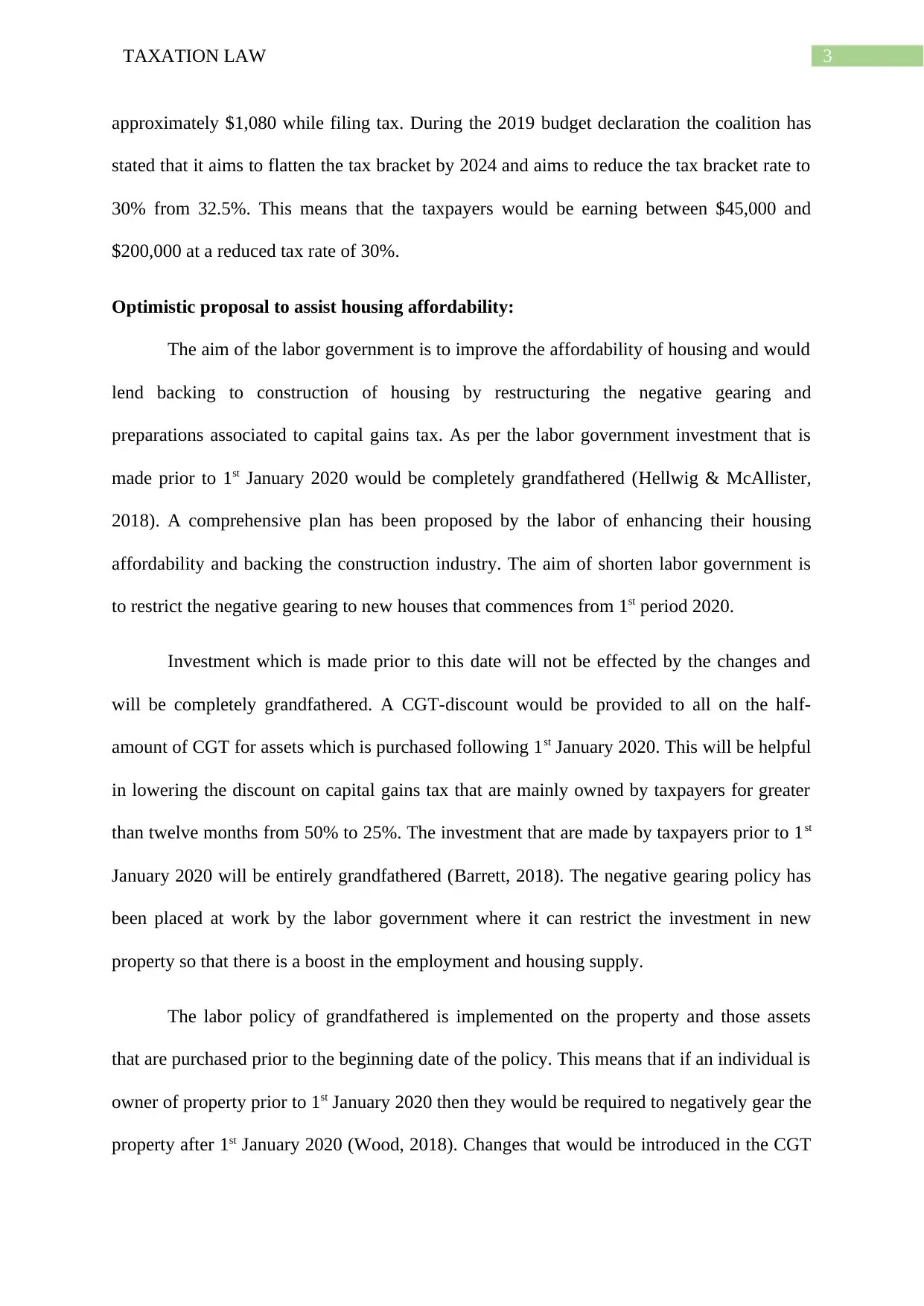
3TAXATION LAW
approximately $1,080 while filing tax. During the 2019 budget declaration the coalition has
stated that it aims to flatten the tax bracket by 2024 and aims to reduce the tax bracket rate to
30% from 32.5%. This means that the taxpayers would be earning between $45,000 and
$200,000 at a reduced tax rate of 30%.
Optimistic proposal to assist housing affordability:
The aim of the labor government is to improve the affordability of housing and would
lend backing to construction of housing by restructuring the negative gearing and
preparations associated to capital gains tax. As per the labor government investment that is
made prior to 1st January 2020 would be completely grandfathered (Hellwig & McAllister,
2018). A comprehensive plan has been proposed by the labor of enhancing their housing
affordability and backing the construction industry. The aim of shorten labor government is
to restrict the negative gearing to new houses that commences from 1st period 2020.
Investment which is made prior to this date will not be effected by the changes and
will be completely grandfathered. A CGT-discount would be provided to all on the half-
amount of CGT for assets which is purchased following 1st January 2020. This will be helpful
in lowering the discount on capital gains tax that are mainly owned by taxpayers for greater
than twelve months from 50% to 25%. The investment that are made by taxpayers prior to 1st
January 2020 will be entirely grandfathered (Barrett, 2018). The negative gearing policy has
been placed at work by the labor government where it can restrict the investment in new
property so that there is a boost in the employment and housing supply.
The labor policy of grandfathered is implemented on the property and those assets
that are purchased prior to the beginning date of the policy. This means that if an individual is
owner of property prior to 1st January 2020 then they would be required to negatively gear the
property after 1st January 2020 (Wood, 2018). Changes that would be introduced in the CGT
approximately $1,080 while filing tax. During the 2019 budget declaration the coalition has
stated that it aims to flatten the tax bracket by 2024 and aims to reduce the tax bracket rate to
30% from 32.5%. This means that the taxpayers would be earning between $45,000 and
$200,000 at a reduced tax rate of 30%.
Optimistic proposal to assist housing affordability:
The aim of the labor government is to improve the affordability of housing and would
lend backing to construction of housing by restructuring the negative gearing and
preparations associated to capital gains tax. As per the labor government investment that is
made prior to 1st January 2020 would be completely grandfathered (Hellwig & McAllister,
2018). A comprehensive plan has been proposed by the labor of enhancing their housing
affordability and backing the construction industry. The aim of shorten labor government is
to restrict the negative gearing to new houses that commences from 1st period 2020.
Investment which is made prior to this date will not be effected by the changes and
will be completely grandfathered. A CGT-discount would be provided to all on the half-
amount of CGT for assets which is purchased following 1st January 2020. This will be helpful
in lowering the discount on capital gains tax that are mainly owned by taxpayers for greater
than twelve months from 50% to 25%. The investment that are made by taxpayers prior to 1st
January 2020 will be entirely grandfathered (Barrett, 2018). The negative gearing policy has
been placed at work by the labor government where it can restrict the investment in new
property so that there is a boost in the employment and housing supply.
The labor policy of grandfathered is implemented on the property and those assets
that are purchased prior to the beginning date of the policy. This means that if an individual is
owner of property prior to 1st January 2020 then they would be required to negatively gear the
property after 1st January 2020 (Wood, 2018). Changes that would be introduced in the CGT
Paraphrase This Document
Need a fresh take? Get an instant paraphrase of this document with our AI Paraphraser

4TAXATION LAW
discount will not be applied on the superfunds and the taxpayer can get 50% reduction in
their active asset which is applicable on small business.
Positive proposal to assist housing affordability:
A shorten labor government will help in improving the affordability of housing and
will lend support in the construction of housing by restructuring the negative gearing and
preparation associated to capital gains tax. As per the labor all the investment which is made
prior to 1st January 2020 will be completely grandfathered (Smith et al., 2019). The labor in
its proposal has stated its comprehensive plan for enhancing the affordability housing and
backing the construction. The shorten labor government targets to restrict the negative
gearing for the new houses commencing from 1st January 2020.
The investment that is made by the taxpayers prior to the aforementioned date will not
be effected by the changes and will completely grandfathered. Half sum of CGT discount will
be provided to the taxpayers that have bought the property following 1st January 2020. The
investment made by taxpayers prior to 1st January 2020 will be grandfathered completely.
The policy can be considered helpful in backing the construction of houses that may
contemplate the 10-year plan to lend support to the building of around $250,000 new low-
cost houses. The policy of labor is more directed towards building the rental housing
construction where an added number of landlords would gain steady long term rents and
added number of houses in the selected sites that are very close to the public transport and
close location of employment opportunities.
Boosting tax concession for institutional investors:
The federal opposition has announced that it will lower the tax for institutional
investors that do construction of rental houses (Battin, 2017). It targets to reduce the managed
investment trust rate withholding on tax distribution that are attributable to investment in the
discount will not be applied on the superfunds and the taxpayer can get 50% reduction in
their active asset which is applicable on small business.
Positive proposal to assist housing affordability:
A shorten labor government will help in improving the affordability of housing and
will lend support in the construction of housing by restructuring the negative gearing and
preparation associated to capital gains tax. As per the labor all the investment which is made
prior to 1st January 2020 will be completely grandfathered (Smith et al., 2019). The labor in
its proposal has stated its comprehensive plan for enhancing the affordability housing and
backing the construction. The shorten labor government targets to restrict the negative
gearing for the new houses commencing from 1st January 2020.
The investment that is made by the taxpayers prior to the aforementioned date will not
be effected by the changes and will completely grandfathered. Half sum of CGT discount will
be provided to the taxpayers that have bought the property following 1st January 2020. The
investment made by taxpayers prior to 1st January 2020 will be grandfathered completely.
The policy can be considered helpful in backing the construction of houses that may
contemplate the 10-year plan to lend support to the building of around $250,000 new low-
cost houses. The policy of labor is more directed towards building the rental housing
construction where an added number of landlords would gain steady long term rents and
added number of houses in the selected sites that are very close to the public transport and
close location of employment opportunities.
Boosting tax concession for institutional investors:
The federal opposition has announced that it will lower the tax for institutional
investors that do construction of rental houses (Battin, 2017). It targets to reduce the managed
investment trust rate withholding on tax distribution that are attributable to investment in the
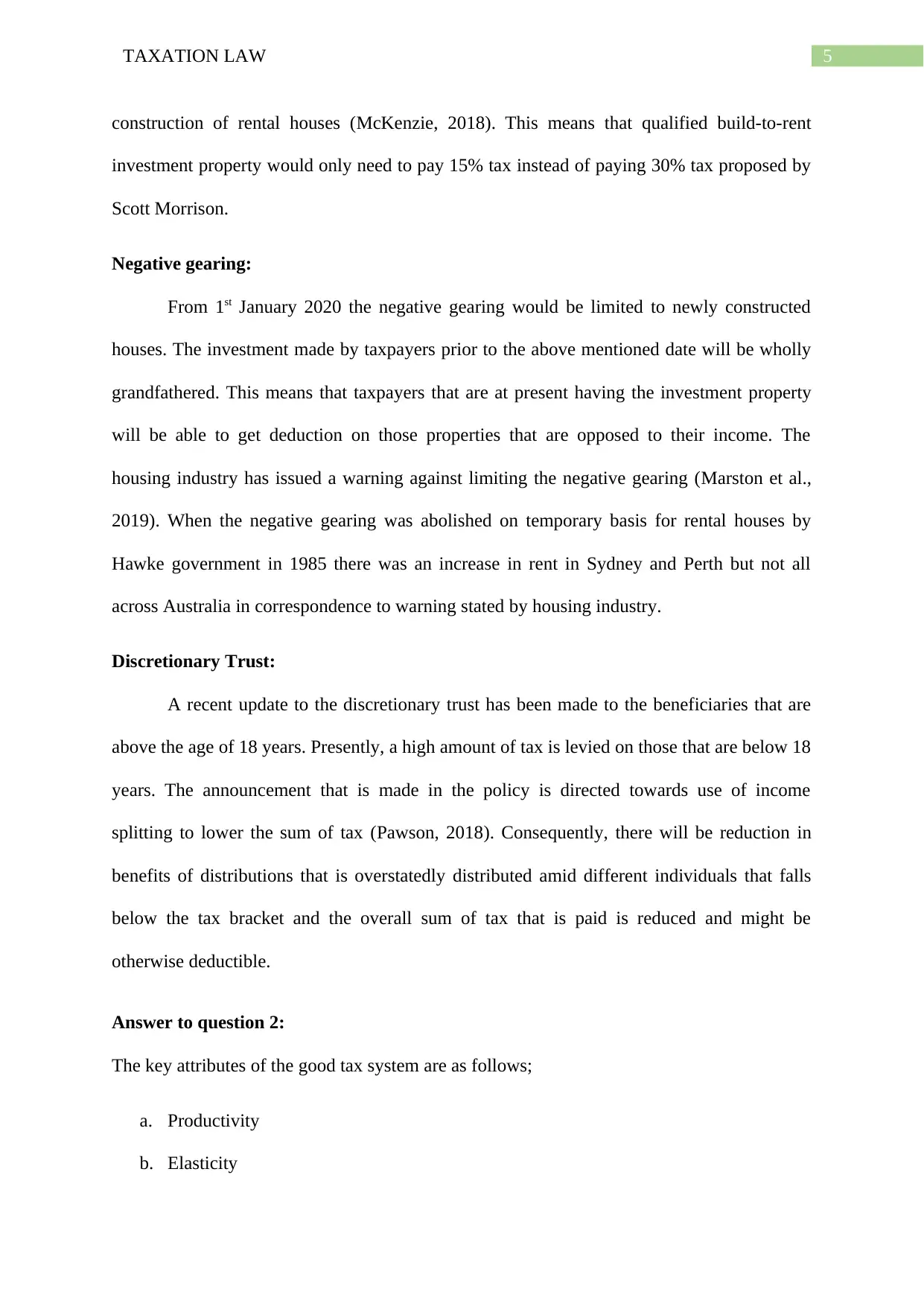
5TAXATION LAW
construction of rental houses (McKenzie, 2018). This means that qualified build-to-rent
investment property would only need to pay 15% tax instead of paying 30% tax proposed by
Scott Morrison.
Negative gearing:
From 1st January 2020 the negative gearing would be limited to newly constructed
houses. The investment made by taxpayers prior to the above mentioned date will be wholly
grandfathered. This means that taxpayers that are at present having the investment property
will be able to get deduction on those properties that are opposed to their income. The
housing industry has issued a warning against limiting the negative gearing (Marston et al.,
2019). When the negative gearing was abolished on temporary basis for rental houses by
Hawke government in 1985 there was an increase in rent in Sydney and Perth but not all
across Australia in correspondence to warning stated by housing industry.
Discretionary Trust:
A recent update to the discretionary trust has been made to the beneficiaries that are
above the age of 18 years. Presently, a high amount of tax is levied on those that are below 18
years. The announcement that is made in the policy is directed towards use of income
splitting to lower the sum of tax (Pawson, 2018). Consequently, there will be reduction in
benefits of distributions that is overstatedly distributed amid different individuals that falls
below the tax bracket and the overall sum of tax that is paid is reduced and might be
otherwise deductible.
Answer to question 2:
The key attributes of the good tax system are as follows;
a. Productivity
b. Elasticity
construction of rental houses (McKenzie, 2018). This means that qualified build-to-rent
investment property would only need to pay 15% tax instead of paying 30% tax proposed by
Scott Morrison.
Negative gearing:
From 1st January 2020 the negative gearing would be limited to newly constructed
houses. The investment made by taxpayers prior to the above mentioned date will be wholly
grandfathered. This means that taxpayers that are at present having the investment property
will be able to get deduction on those properties that are opposed to their income. The
housing industry has issued a warning against limiting the negative gearing (Marston et al.,
2019). When the negative gearing was abolished on temporary basis for rental houses by
Hawke government in 1985 there was an increase in rent in Sydney and Perth but not all
across Australia in correspondence to warning stated by housing industry.
Discretionary Trust:
A recent update to the discretionary trust has been made to the beneficiaries that are
above the age of 18 years. Presently, a high amount of tax is levied on those that are below 18
years. The announcement that is made in the policy is directed towards use of income
splitting to lower the sum of tax (Pawson, 2018). Consequently, there will be reduction in
benefits of distributions that is overstatedly distributed amid different individuals that falls
below the tax bracket and the overall sum of tax that is paid is reduced and might be
otherwise deductible.
Answer to question 2:
The key attributes of the good tax system are as follows;
a. Productivity
b. Elasticity
⊘ This is a preview!⊘
Do you want full access?
Subscribe today to unlock all pages.

Trusted by 1+ million students worldwide
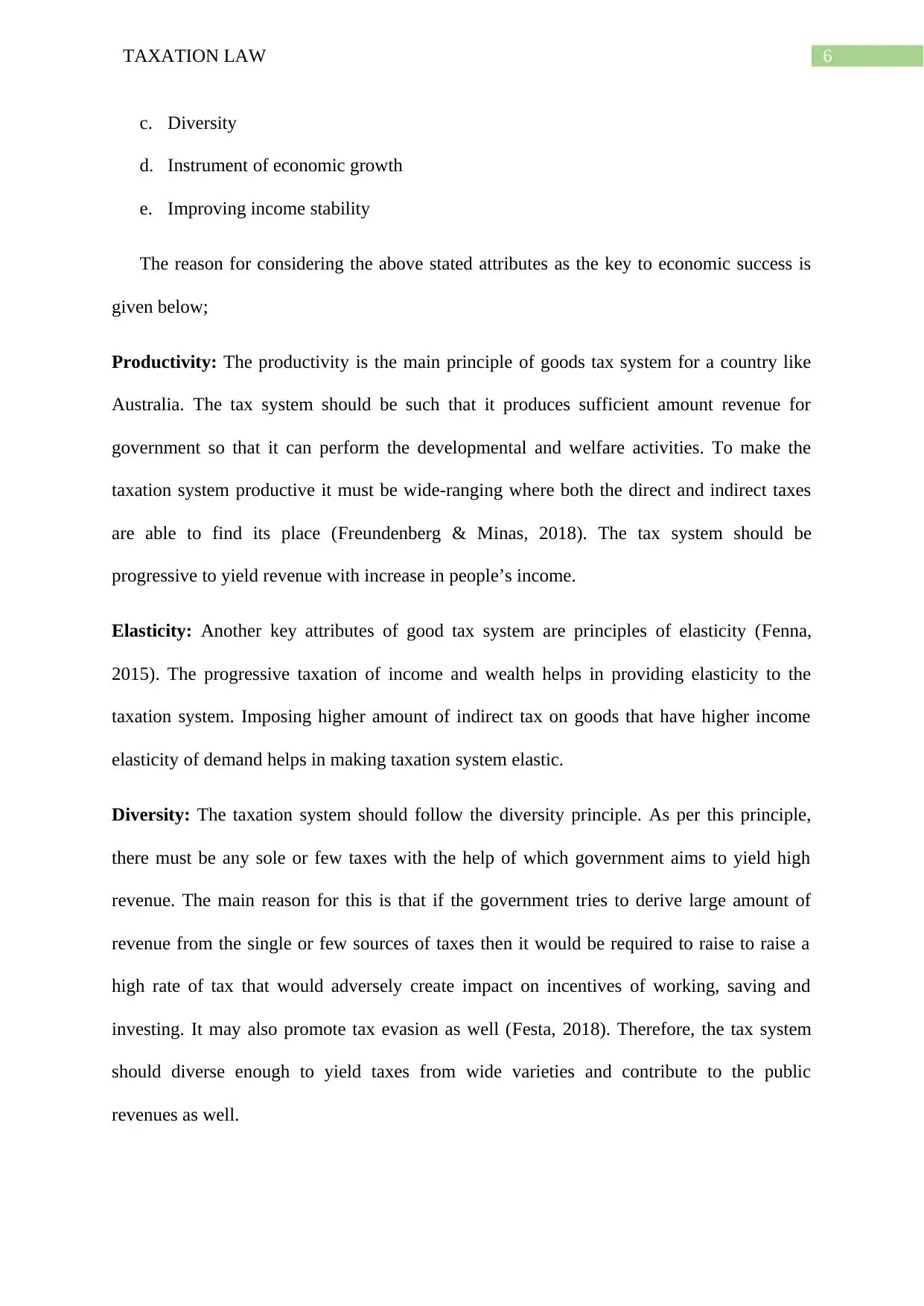
6TAXATION LAW
c. Diversity
d. Instrument of economic growth
e. Improving income stability
The reason for considering the above stated attributes as the key to economic success is
given below;
Productivity: The productivity is the main principle of goods tax system for a country like
Australia. The tax system should be such that it produces sufficient amount revenue for
government so that it can perform the developmental and welfare activities. To make the
taxation system productive it must be wide-ranging where both the direct and indirect taxes
are able to find its place (Freundenberg & Minas, 2018). The tax system should be
progressive to yield revenue with increase in people’s income.
Elasticity: Another key attributes of good tax system are principles of elasticity (Fenna,
2015). The progressive taxation of income and wealth helps in providing elasticity to the
taxation system. Imposing higher amount of indirect tax on goods that have higher income
elasticity of demand helps in making taxation system elastic.
Diversity: The taxation system should follow the diversity principle. As per this principle,
there must be any sole or few taxes with the help of which government aims to yield high
revenue. The main reason for this is that if the government tries to derive large amount of
revenue from the single or few sources of taxes then it would be required to raise to raise a
high rate of tax that would adversely create impact on incentives of working, saving and
investing. It may also promote tax evasion as well (Festa, 2018). Therefore, the tax system
should diverse enough to yield taxes from wide varieties and contribute to the public
revenues as well.
c. Diversity
d. Instrument of economic growth
e. Improving income stability
The reason for considering the above stated attributes as the key to economic success is
given below;
Productivity: The productivity is the main principle of goods tax system for a country like
Australia. The tax system should be such that it produces sufficient amount revenue for
government so that it can perform the developmental and welfare activities. To make the
taxation system productive it must be wide-ranging where both the direct and indirect taxes
are able to find its place (Freundenberg & Minas, 2018). The tax system should be
progressive to yield revenue with increase in people’s income.
Elasticity: Another key attributes of good tax system are principles of elasticity (Fenna,
2015). The progressive taxation of income and wealth helps in providing elasticity to the
taxation system. Imposing higher amount of indirect tax on goods that have higher income
elasticity of demand helps in making taxation system elastic.
Diversity: The taxation system should follow the diversity principle. As per this principle,
there must be any sole or few taxes with the help of which government aims to yield high
revenue. The main reason for this is that if the government tries to derive large amount of
revenue from the single or few sources of taxes then it would be required to raise to raise a
high rate of tax that would adversely create impact on incentives of working, saving and
investing. It may also promote tax evasion as well (Festa, 2018). Therefore, the tax system
should diverse enough to yield taxes from wide varieties and contribute to the public
revenues as well.
Paraphrase This Document
Need a fresh take? Get an instant paraphrase of this document with our AI Paraphraser
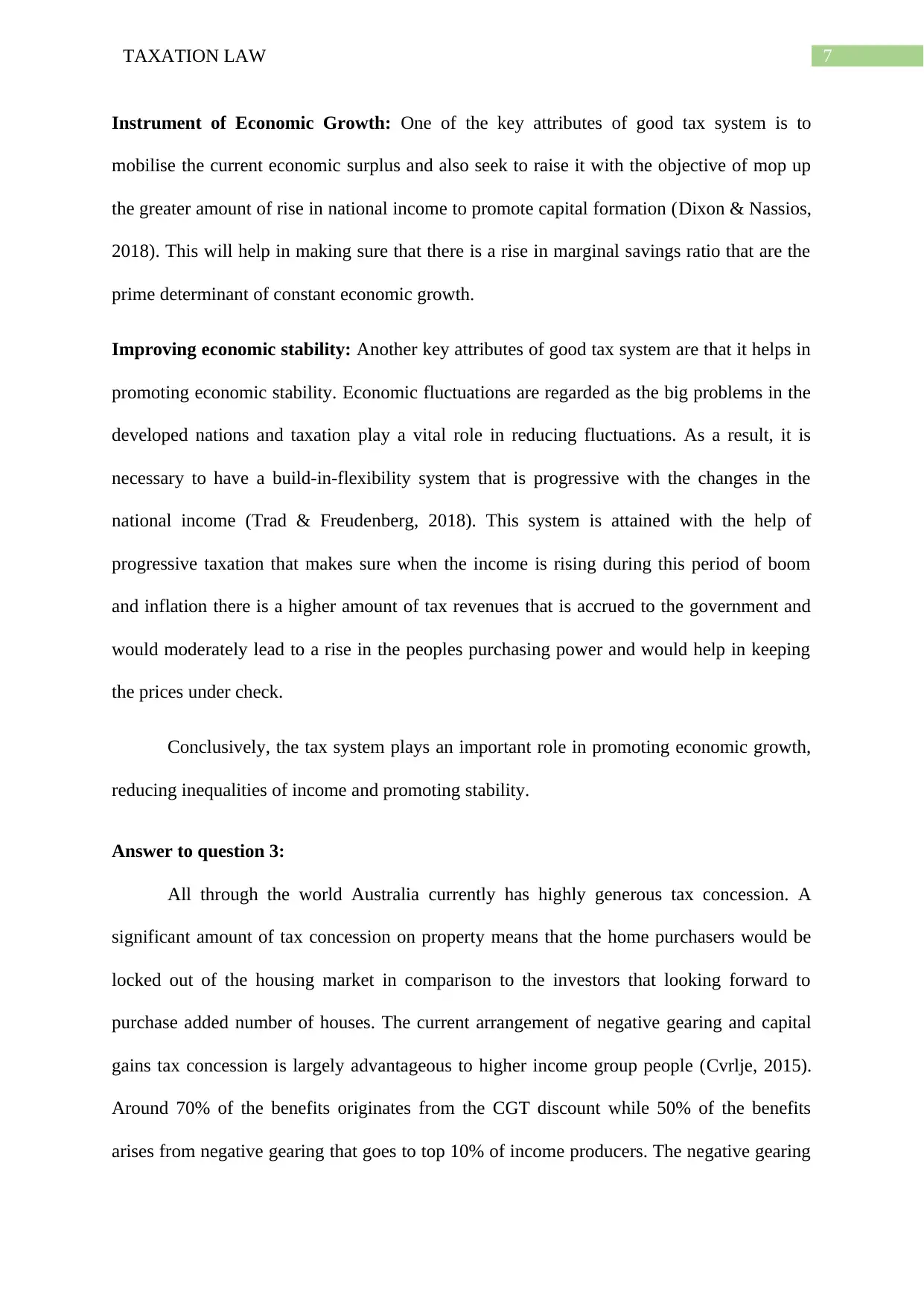
7TAXATION LAW
Instrument of Economic Growth: One of the key attributes of good tax system is to
mobilise the current economic surplus and also seek to raise it with the objective of mop up
the greater amount of rise in national income to promote capital formation (Dixon & Nassios,
2018). This will help in making sure that there is a rise in marginal savings ratio that are the
prime determinant of constant economic growth.
Improving economic stability: Another key attributes of good tax system are that it helps in
promoting economic stability. Economic fluctuations are regarded as the big problems in the
developed nations and taxation play a vital role in reducing fluctuations. As a result, it is
necessary to have a build-in-flexibility system that is progressive with the changes in the
national income (Trad & Freudenberg, 2018). This system is attained with the help of
progressive taxation that makes sure when the income is rising during this period of boom
and inflation there is a higher amount of tax revenues that is accrued to the government and
would moderately lead to a rise in the peoples purchasing power and would help in keeping
the prices under check.
Conclusively, the tax system plays an important role in promoting economic growth,
reducing inequalities of income and promoting stability.
Answer to question 3:
All through the world Australia currently has highly generous tax concession. A
significant amount of tax concession on property means that the home purchasers would be
locked out of the housing market in comparison to the investors that looking forward to
purchase added number of houses. The current arrangement of negative gearing and capital
gains tax concession is largely advantageous to higher income group people (Cvrlje, 2015).
Around 70% of the benefits originates from the CGT discount while 50% of the benefits
arises from negative gearing that goes to top 10% of income producers. The negative gearing
Instrument of Economic Growth: One of the key attributes of good tax system is to
mobilise the current economic surplus and also seek to raise it with the objective of mop up
the greater amount of rise in national income to promote capital formation (Dixon & Nassios,
2018). This will help in making sure that there is a rise in marginal savings ratio that are the
prime determinant of constant economic growth.
Improving economic stability: Another key attributes of good tax system are that it helps in
promoting economic stability. Economic fluctuations are regarded as the big problems in the
developed nations and taxation play a vital role in reducing fluctuations. As a result, it is
necessary to have a build-in-flexibility system that is progressive with the changes in the
national income (Trad & Freudenberg, 2018). This system is attained with the help of
progressive taxation that makes sure when the income is rising during this period of boom
and inflation there is a higher amount of tax revenues that is accrued to the government and
would moderately lead to a rise in the peoples purchasing power and would help in keeping
the prices under check.
Conclusively, the tax system plays an important role in promoting economic growth,
reducing inequalities of income and promoting stability.
Answer to question 3:
All through the world Australia currently has highly generous tax concession. A
significant amount of tax concession on property means that the home purchasers would be
locked out of the housing market in comparison to the investors that looking forward to
purchase added number of houses. The current arrangement of negative gearing and capital
gains tax concession is largely advantageous to higher income group people (Cvrlje, 2015).
Around 70% of the benefits originates from the CGT discount while 50% of the benefits
arises from negative gearing that goes to top 10% of income producers. The negative gearing
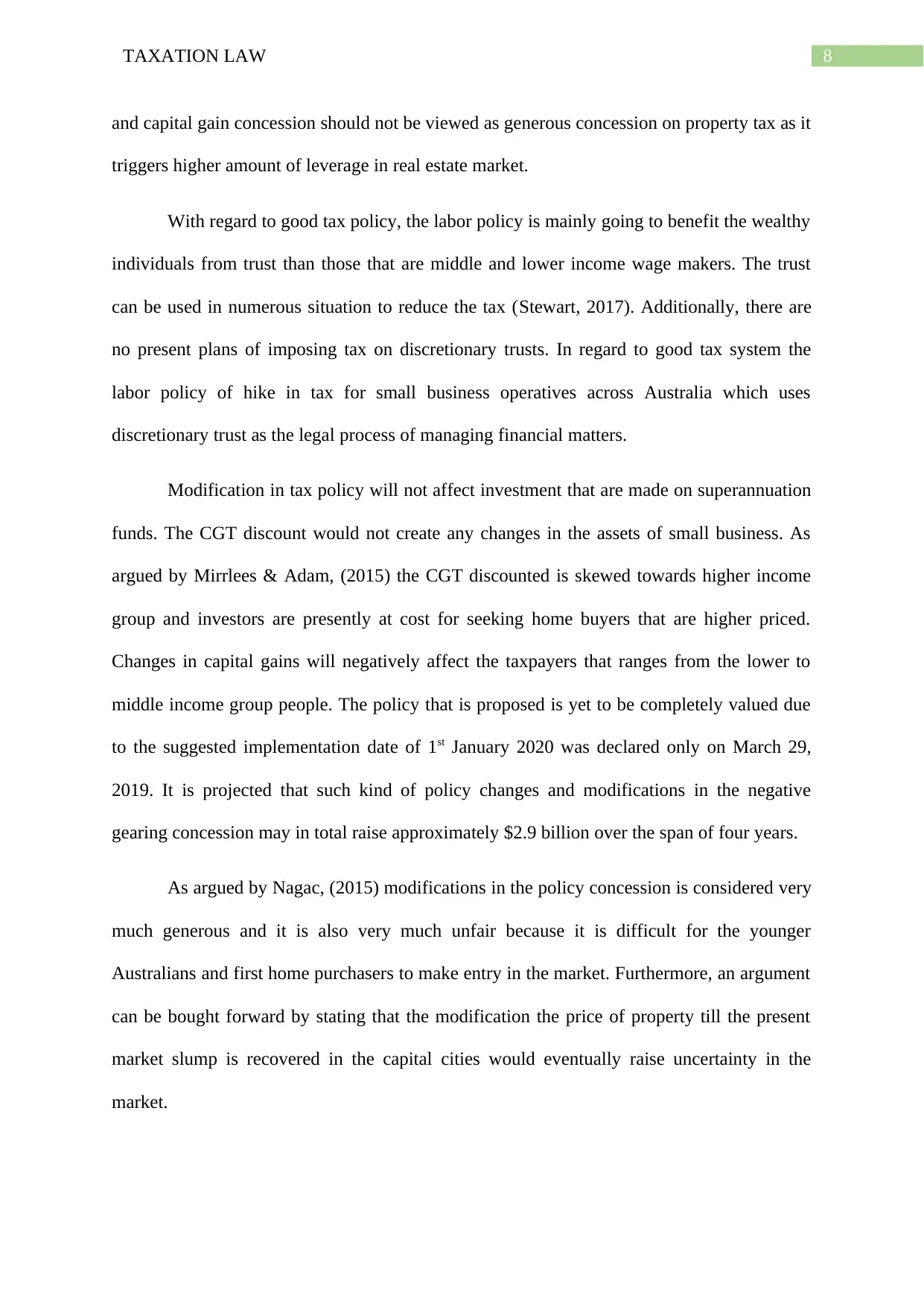
8TAXATION LAW
and capital gain concession should not be viewed as generous concession on property tax as it
triggers higher amount of leverage in real estate market.
With regard to good tax policy, the labor policy is mainly going to benefit the wealthy
individuals from trust than those that are middle and lower income wage makers. The trust
can be used in numerous situation to reduce the tax (Stewart, 2017). Additionally, there are
no present plans of imposing tax on discretionary trusts. In regard to good tax system the
labor policy of hike in tax for small business operatives across Australia which uses
discretionary trust as the legal process of managing financial matters.
Modification in tax policy will not affect investment that are made on superannuation
funds. The CGT discount would not create any changes in the assets of small business. As
argued by Mirrlees & Adam, (2015) the CGT discounted is skewed towards higher income
group and investors are presently at cost for seeking home buyers that are higher priced.
Changes in capital gains will negatively affect the taxpayers that ranges from the lower to
middle income group people. The policy that is proposed is yet to be completely valued due
to the suggested implementation date of 1st January 2020 was declared only on March 29,
2019. It is projected that such kind of policy changes and modifications in the negative
gearing concession may in total raise approximately $2.9 billion over the span of four years.
As argued by Nagac, (2015) modifications in the policy concession is considered very
much generous and it is also very much unfair because it is difficult for the younger
Australians and first home purchasers to make entry in the market. Furthermore, an argument
can be bought forward by stating that the modification the price of property till the present
market slump is recovered in the capital cities would eventually raise uncertainty in the
market.
and capital gain concession should not be viewed as generous concession on property tax as it
triggers higher amount of leverage in real estate market.
With regard to good tax policy, the labor policy is mainly going to benefit the wealthy
individuals from trust than those that are middle and lower income wage makers. The trust
can be used in numerous situation to reduce the tax (Stewart, 2017). Additionally, there are
no present plans of imposing tax on discretionary trusts. In regard to good tax system the
labor policy of hike in tax for small business operatives across Australia which uses
discretionary trust as the legal process of managing financial matters.
Modification in tax policy will not affect investment that are made on superannuation
funds. The CGT discount would not create any changes in the assets of small business. As
argued by Mirrlees & Adam, (2015) the CGT discounted is skewed towards higher income
group and investors are presently at cost for seeking home buyers that are higher priced.
Changes in capital gains will negatively affect the taxpayers that ranges from the lower to
middle income group people. The policy that is proposed is yet to be completely valued due
to the suggested implementation date of 1st January 2020 was declared only on March 29,
2019. It is projected that such kind of policy changes and modifications in the negative
gearing concession may in total raise approximately $2.9 billion over the span of four years.
As argued by Nagac, (2015) modifications in the policy concession is considered very
much generous and it is also very much unfair because it is difficult for the younger
Australians and first home purchasers to make entry in the market. Furthermore, an argument
can be bought forward by stating that the modification the price of property till the present
market slump is recovered in the capital cities would eventually raise uncertainty in the
market.
⊘ This is a preview!⊘
Do you want full access?
Subscribe today to unlock all pages.

Trusted by 1+ million students worldwide
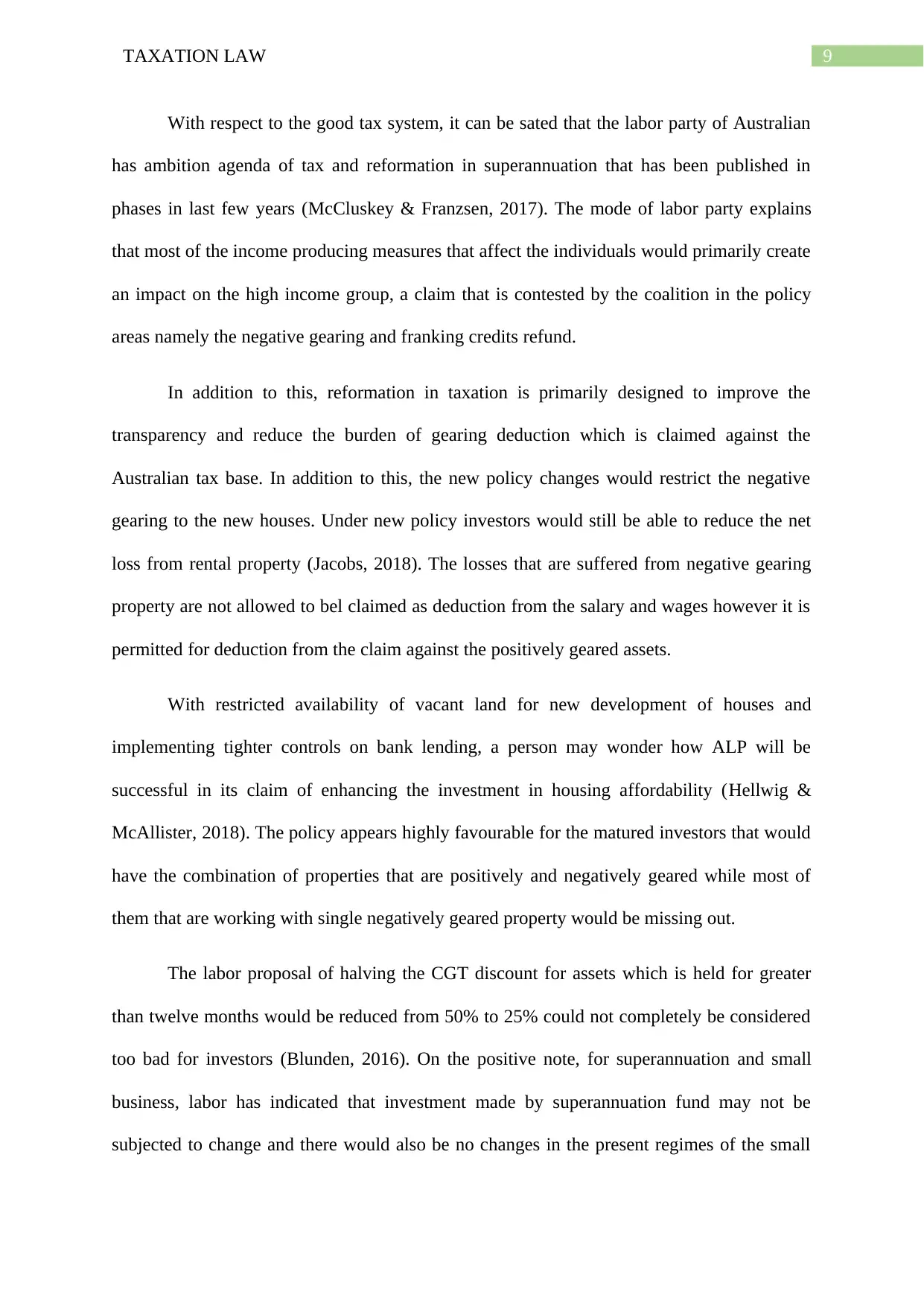
9TAXATION LAW
With respect to the good tax system, it can be sated that the labor party of Australian
has ambition agenda of tax and reformation in superannuation that has been published in
phases in last few years (McCluskey & Franzsen, 2017). The mode of labor party explains
that most of the income producing measures that affect the individuals would primarily create
an impact on the high income group, a claim that is contested by the coalition in the policy
areas namely the negative gearing and franking credits refund.
In addition to this, reformation in taxation is primarily designed to improve the
transparency and reduce the burden of gearing deduction which is claimed against the
Australian tax base. In addition to this, the new policy changes would restrict the negative
gearing to the new houses. Under new policy investors would still be able to reduce the net
loss from rental property (Jacobs, 2018). The losses that are suffered from negative gearing
property are not allowed to bel claimed as deduction from the salary and wages however it is
permitted for deduction from the claim against the positively geared assets.
With restricted availability of vacant land for new development of houses and
implementing tighter controls on bank lending, a person may wonder how ALP will be
successful in its claim of enhancing the investment in housing affordability (Hellwig &
McAllister, 2018). The policy appears highly favourable for the matured investors that would
have the combination of properties that are positively and negatively geared while most of
them that are working with single negatively geared property would be missing out.
The labor proposal of halving the CGT discount for assets which is held for greater
than twelve months would be reduced from 50% to 25% could not completely be considered
too bad for investors (Blunden, 2016). On the positive note, for superannuation and small
business, labor has indicated that investment made by superannuation fund may not be
subjected to change and there would also be no changes in the present regimes of the small
With respect to the good tax system, it can be sated that the labor party of Australian
has ambition agenda of tax and reformation in superannuation that has been published in
phases in last few years (McCluskey & Franzsen, 2017). The mode of labor party explains
that most of the income producing measures that affect the individuals would primarily create
an impact on the high income group, a claim that is contested by the coalition in the policy
areas namely the negative gearing and franking credits refund.
In addition to this, reformation in taxation is primarily designed to improve the
transparency and reduce the burden of gearing deduction which is claimed against the
Australian tax base. In addition to this, the new policy changes would restrict the negative
gearing to the new houses. Under new policy investors would still be able to reduce the net
loss from rental property (Jacobs, 2018). The losses that are suffered from negative gearing
property are not allowed to bel claimed as deduction from the salary and wages however it is
permitted for deduction from the claim against the positively geared assets.
With restricted availability of vacant land for new development of houses and
implementing tighter controls on bank lending, a person may wonder how ALP will be
successful in its claim of enhancing the investment in housing affordability (Hellwig &
McAllister, 2018). The policy appears highly favourable for the matured investors that would
have the combination of properties that are positively and negatively geared while most of
them that are working with single negatively geared property would be missing out.
The labor proposal of halving the CGT discount for assets which is held for greater
than twelve months would be reduced from 50% to 25% could not completely be considered
too bad for investors (Blunden, 2016). On the positive note, for superannuation and small
business, labor has indicated that investment made by superannuation fund may not be
subjected to change and there would also be no changes in the present regimes of the small
Paraphrase This Document
Need a fresh take? Get an instant paraphrase of this document with our AI Paraphraser
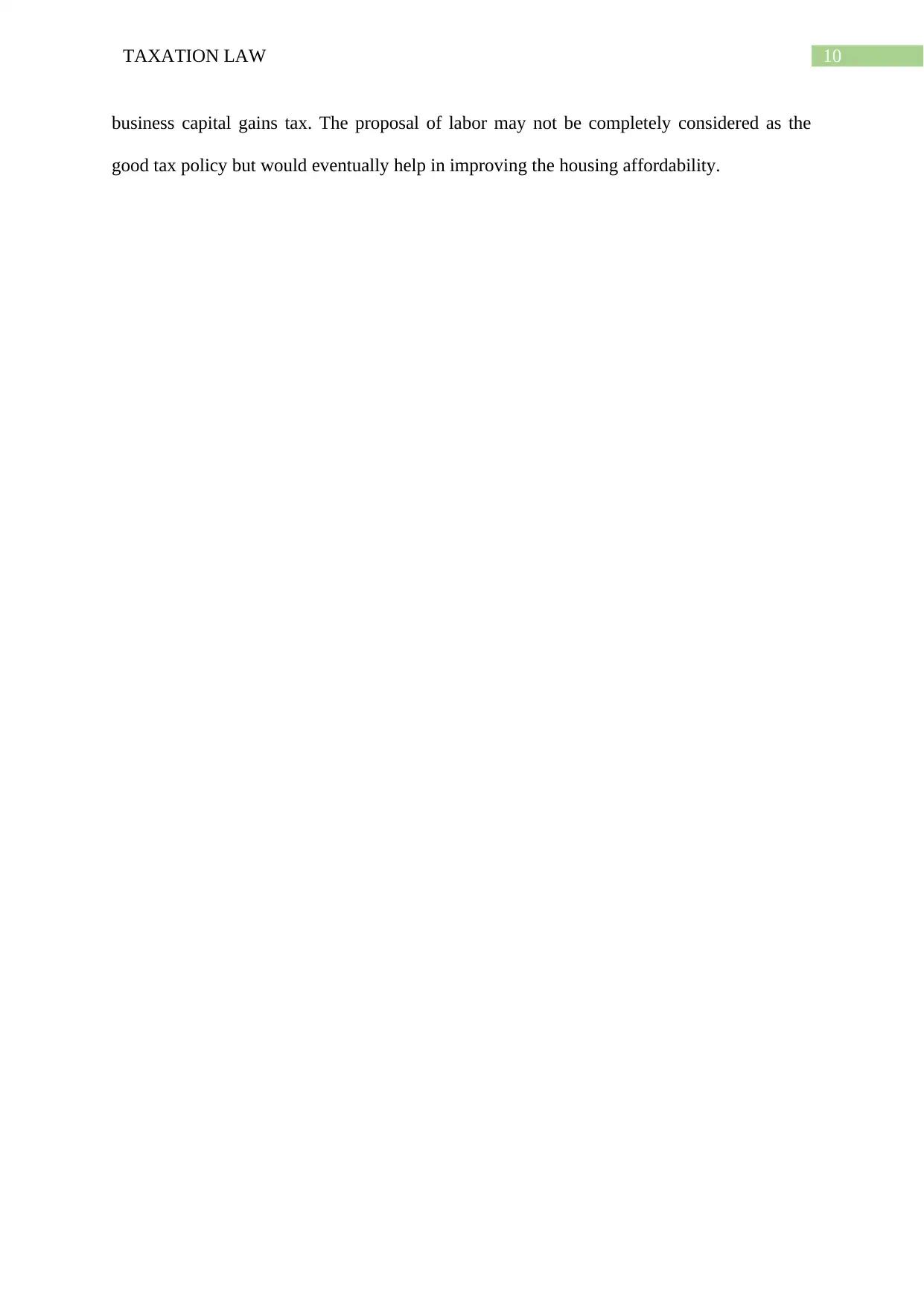
10TAXATION LAW
business capital gains tax. The proposal of labor may not be completely considered as the
good tax policy but would eventually help in improving the housing affordability.
business capital gains tax. The proposal of labor may not be completely considered as the
good tax policy but would eventually help in improving the housing affordability.
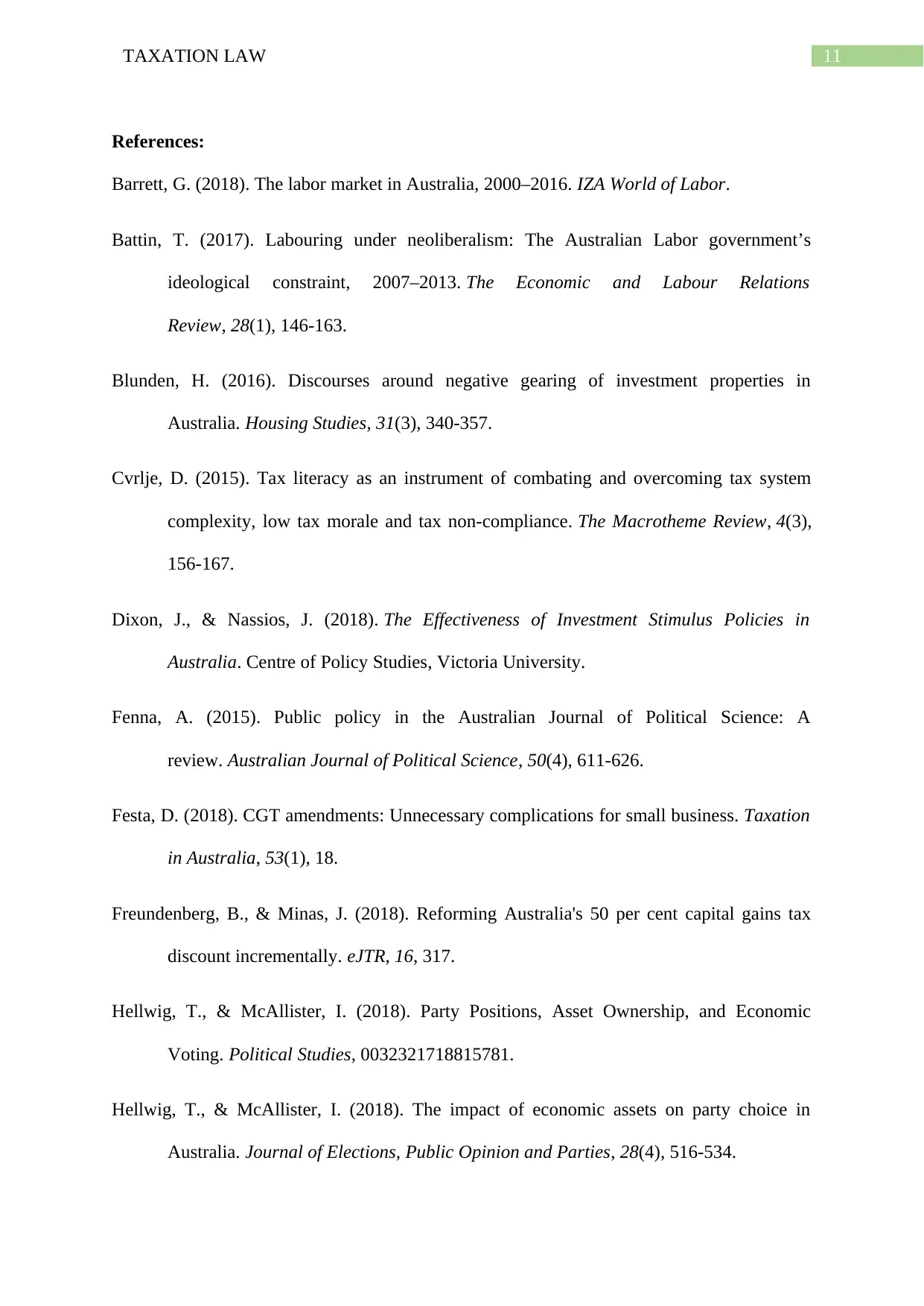
11TAXATION LAW
References:
Barrett, G. (2018). The labor market in Australia, 2000–2016. IZA World of Labor.
Battin, T. (2017). Labouring under neoliberalism: The Australian Labor government’s
ideological constraint, 2007–2013. The Economic and Labour Relations
Review, 28(1), 146-163.
Blunden, H. (2016). Discourses around negative gearing of investment properties in
Australia. Housing Studies, 31(3), 340-357.
Cvrlje, D. (2015). Tax literacy as an instrument of combating and overcoming tax system
complexity, low tax morale and tax non-compliance. The Macrotheme Review, 4(3),
156-167.
Dixon, J., & Nassios, J. (2018). The Effectiveness of Investment Stimulus Policies in
Australia. Centre of Policy Studies, Victoria University.
Fenna, A. (2015). Public policy in the Australian Journal of Political Science: A
review. Australian Journal of Political Science, 50(4), 611-626.
Festa, D. (2018). CGT amendments: Unnecessary complications for small business. Taxation
in Australia, 53(1), 18.
Freundenberg, B., & Minas, J. (2018). Reforming Australia's 50 per cent capital gains tax
discount incrementally. eJTR, 16, 317.
Hellwig, T., & McAllister, I. (2018). Party Positions, Asset Ownership, and Economic
Voting. Political Studies, 0032321718815781.
Hellwig, T., & McAllister, I. (2018). The impact of economic assets on party choice in
Australia. Journal of Elections, Public Opinion and Parties, 28(4), 516-534.
References:
Barrett, G. (2018). The labor market in Australia, 2000–2016. IZA World of Labor.
Battin, T. (2017). Labouring under neoliberalism: The Australian Labor government’s
ideological constraint, 2007–2013. The Economic and Labour Relations
Review, 28(1), 146-163.
Blunden, H. (2016). Discourses around negative gearing of investment properties in
Australia. Housing Studies, 31(3), 340-357.
Cvrlje, D. (2015). Tax literacy as an instrument of combating and overcoming tax system
complexity, low tax morale and tax non-compliance. The Macrotheme Review, 4(3),
156-167.
Dixon, J., & Nassios, J. (2018). The Effectiveness of Investment Stimulus Policies in
Australia. Centre of Policy Studies, Victoria University.
Fenna, A. (2015). Public policy in the Australian Journal of Political Science: A
review. Australian Journal of Political Science, 50(4), 611-626.
Festa, D. (2018). CGT amendments: Unnecessary complications for small business. Taxation
in Australia, 53(1), 18.
Freundenberg, B., & Minas, J. (2018). Reforming Australia's 50 per cent capital gains tax
discount incrementally. eJTR, 16, 317.
Hellwig, T., & McAllister, I. (2018). Party Positions, Asset Ownership, and Economic
Voting. Political Studies, 0032321718815781.
Hellwig, T., & McAllister, I. (2018). The impact of economic assets on party choice in
Australia. Journal of Elections, Public Opinion and Parties, 28(4), 516-534.
⊘ This is a preview!⊘
Do you want full access?
Subscribe today to unlock all pages.

Trusted by 1+ million students worldwide
1 out of 14
Related Documents
Your All-in-One AI-Powered Toolkit for Academic Success.
+13062052269
info@desklib.com
Available 24*7 on WhatsApp / Email
![[object Object]](/_next/static/media/star-bottom.7253800d.svg)
Unlock your academic potential
Copyright © 2020–2025 A2Z Services. All Rights Reserved. Developed and managed by ZUCOL.


